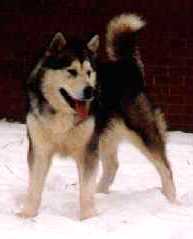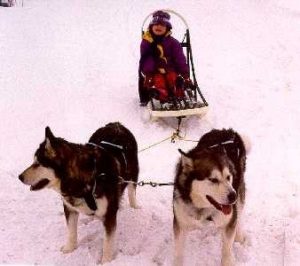
Breeders, like show judges, have to make choices, because there are no perfect Malamutes. Every Malamute has faults. How we choose our breeding dogs reflects our priorities, just as much as how we choose our dogs in the ring. But in the ring a judge has two minutes to make his decision about a dog. In the breeding kennel, a breeder has the lifetime of the dog, plus all the previous relatives, plus all the offspring to consider before making her decision. At Wayeh, we choose temperament, health, structure, working ability and then type.
Temperament is more than passing tests. Sound temperament means is the dog safe in public, is he non-confrontational, is he a joy to be around with children and strange situations. Sound temperament means surprises are accepted, even confrontational dogs are accepted — to a point — and can he settle down and turn off when asked to?

Health is the whole dog. Does he have a robust immune system, are his hips, eyes, and thyroid above average? Are his littermates and half-siblings, parents and their siblings, all healthy dogs with robust immune systems and certified hips, eyes, and thyroid?
Reproductive soundness is more than fertility. Can the dog reproduce himself naturally or does he need help? Can she mate, conceive, whelp and nurse a litter without help? Is she a fair mother, or harsh? Does she allow people to visit the puppies, or is she protective? Can they reproduce later in life. For males, 11-years-old is ideal because you have a track record of HIS health and his other offspring to go on. If he CAN reproduce naturally at 11, then he is not only alive at 11, but is healthy enough to be fertile. Far too many dogs are shown and reproduce in their young adulthood and then never heard from again.
Pedigree is the depth of the pedigree (father, mothers, grands, and great-grands) and the breadth of the pedigree (siblings, half-siblings, aunts and uncles) and the structure of the pedigree. Are the dogs in the pedigree, depth and breadth, healthy dogs with strong immune systems, health clearances, soundness into their teens, with robust longevity? Are the dogs in the pedigree, depth and breadth, producers of strong immune systems and health clearances? Is the pedigree inbred, outcrossed, or a combination? Which dogs have the most influence, what are the numbers (COI/COR) over 10 generations, not just 5? What did those past and present influential dogs produce? What are the strengths of this pedigree? What are the problems — and there are always problems. If you have a pedigree that produced a severe illness, don’t match it with a pedigree that produced the same severe illness, and for Pete’s sake, don’t inbred or linebred on that pedigree or you’ll increase the chances of reproducing that same severe illness. If this is an outcrossed pedigree, do you want to breed back into one part of it, or continue outcrossing on temperament, health, reproductive health, structure, and working ability? If you want to reproduce type, you’ll either have to find a similar phenotype or inbreed.

Working ability is what makes a Malamute a survivor on his home ground… the arctic, the most inhospitable environment on earth. A dog that looks like a Malamute but can’t do the job is not a good Malamute. Pretty is as pretty does. The job is not gaiting around a show ring twice in the air conditioning, it is in harness, head down, and moving a load across miles of back country, and not just 16 feet of track. He has to do this on a team and he has to do this consistently, not just one long weekend. Working ability (heart) can overcome structure weaknesses, to an extent, but it can not overcome temperament faults if the handler is honest with herself. Teamwork means the dog will follow the leader and do his job and not be a danger at every water break or rest stop. Even if he is a pest or a pain in the butt.
Movement and structure are part and parcel of working ability, but the dog can have structure and movement faults and still have the heart to do the job, even for years at a time. He’ll just give out or break down before a more sound dog will over the course of his lifetime.
Type is what the dog LOOKs like, head, stacked profile and moving. Is he a heavy, square dog or a tall, lean dog? Does he have a round bear head or an angular wolf head? Does he extend and drive freely and in balance? Does he converge towards the center line? Does he exemplify power and strength and moderation? These are STYLES specific and beloved to individual kennels and are equally correct… despite passionate arguments (not to say fisticuffs and lifelong grudges) on both sides of that debate. But looking at original Malamutes (link), they came in a wide range of STYLE while still maintaining the essential TYPE.

The first thing most people notice about a Malamute is the soft expression of that arctic head. But it is the last thing I consider when I’m selecting for a breeding because a beautiful head on a hateful dog or one who only lives to be 5 years old, is not a beautiful dog. But I do consider it, because I have style preferences like everyone else.
Temperament, health, structure, working ability, then type — because a good Malamute must be a good dog first.